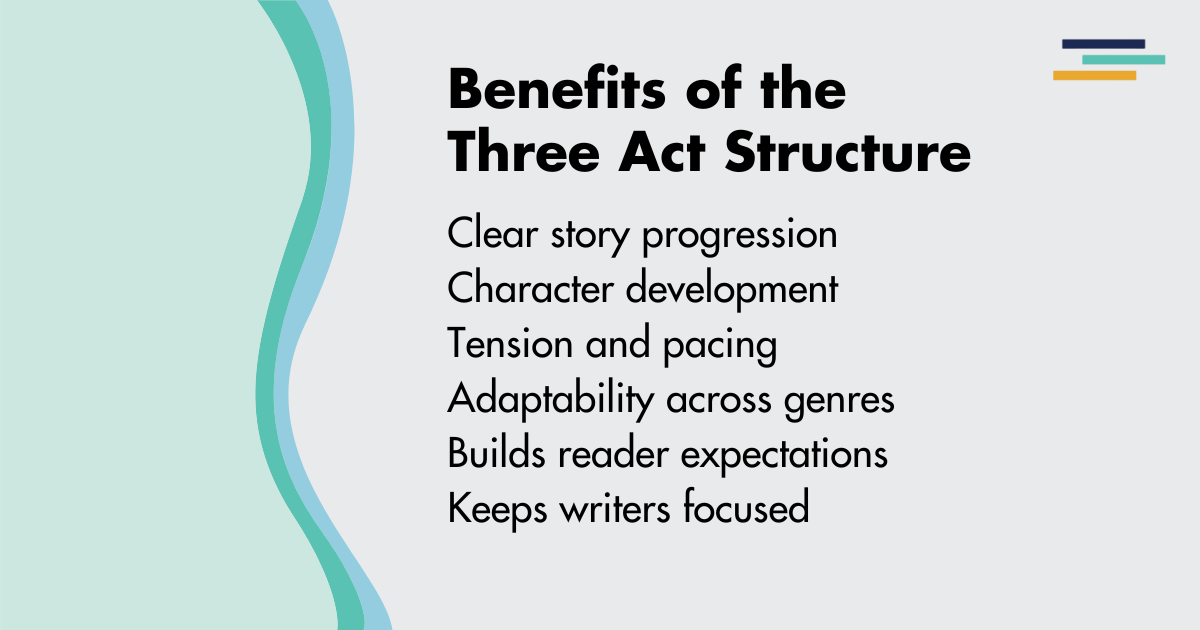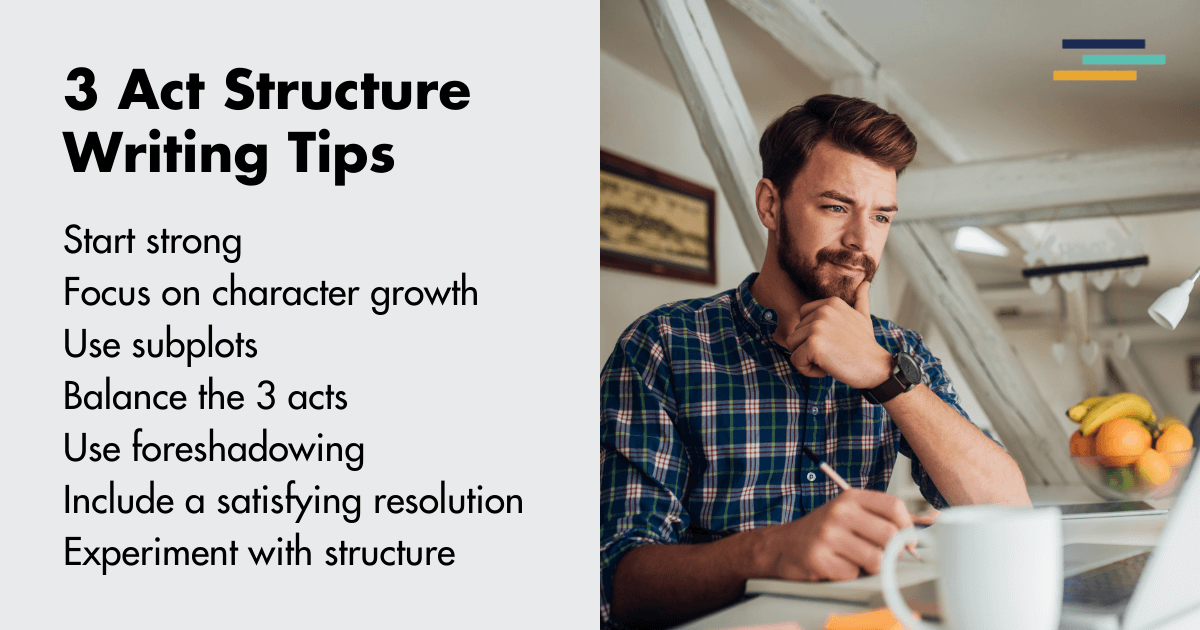
The three-act structure is a storytelling framework that has stood the test of time.
Whether you’re writing a novel, screenplay, or short story, understanding the three-act structure can help you build a strong narrative foundation. It offers a clear path for your characters, allowing your story to rise, fall, and resolve with an engaging flow that keeps readers (or viewers) hooked.
In this article, we’ll explore the ins and outs of the three-act structure, its benefits, and how you can apply it to your own work.
We’ll also dive into some famous examples from film and literature to show you how this timeless framework has been successfully used across different genres.
And yes, we’ll do it with a dash of subtle humor along the way.
Take a free trial of Fictionary today and take your story to the next level.
What Is the Three Act Structure?
The three-act structure divides a story into three distinct parts:
- The Setup
- The Confrontation
- The Resolution
These parts serve as the backbone of your narrative, ensuring that your plot progresses in a satisfying and coherent way.
Act One: The Setup
Act One introduces your characters, setting, and central conflict.
This is where you lay the story’s foundation, and set the protagonist’s world into motion. By the end of Act One, you’ll hit a turning point that propels the character into Act Two.
Act Two: The Confrontation
Act Two is where the action ramps up.
Your protagonist becomes fully immersed in the central conflict, and the stakes are continually rising. This act typically ends with a climactic twist or a major setback for the protagonist, leading to the last act.
Act Three: The Resolution
In Act Three, the story reaches its climax.
This is the point where all the built-up tension gets released, and the protagonist faces their biggest challenge.
By the end of this act, the central conflict gets resolved, whether for better or worse, and you tie up any loose ends.

The Benefits of the Three Act Structure
Why use the three-act structure? It’s a proven framework for building engaging, well-paced stories.
Here are a few benefits.
1. Clear Story Progression
The three-act structure provides a logical flow, ensuring that your story moves forward with purpose.
In Act One, you introduce the key characters and their world, setting the stage for the major conflict. Act Two ramps up the tension, putting your protagonist through increasingly tough challenges. Finally, Act Three brings everything together, delivering the climax and resolution.
Each act builds on the previous one, creating a sense of momentum that keeps readers engaged.
2. Character Development
One of the greatest strengths of the three-act structure is how it supports character growth.
Act One lays out your protagonist’s goals and flaws, Act Two tests them in increasingly challenging ways, and by Act Three, they have (hopefully) evolved.
It gives you a defined framework to show how your characters change over time, whether they’re overcoming fears, learning important life lessons, or simply growing into the role the story demands of them.
It’s like watching someone run a marathon.
They may start fresh, but by the end, they’ve transformed in some meaningful way.
3. Tension and Pacing
A well-paced story keeps readers turning the pages, and the three-act structure is a masterclass in managing tension.
Act One sets the stakes, Act Two raises them, and Act Three delivers the payoff.
By controlling the rise and fall of tension, you ensure readers stay invested without feeling overwhelmed or bored. It’s the literary equivalent of a rollercoaster. If the buildup is too slow or the climax underwhelming, your audience will feel let down.
But nail the pacing, and they’ll be strapped in for the ride from start to finish.
4. Adaptability Across Genres
The three-act structure is incredibly versatile, working across virtually every genre.
Whether you’re writing a cozy romance, a pulse-pounding thriller, or a complex sci-fi epic, the framework remains the same. You simply adjust the tone, pacing, and specific plot points to suit your genre.
And hey, who doesn’t love a good story structure that’s just as effective in Pride and Prejudice as it is in The Hunger Games?
5. Builds Reader Expectations
The beauty of the three-act structure lies in its familiarity.
Readers intuitively know how stories using this framework unfold, which means they come in with certain expectations…
Expectations you can play with, meet, or subvert.
In Act One, they expect to learn about the protagonist and the problem. By Act Two, they know things should get tough, and in Act Three, they expect the big payoff.
While this predictability might seem like a limitation, it’s actually a great tool. You can lead readers down familiar paths only to surprise them, or give them exactly what they expect…
But better than they imagined.
6. Keeps You Focused
Writing a story is like juggling a thousand balls at once, including:
- Plot
- Character Arcs
- Subplots
- World-building
- Dialogue
And more.
The three-act structure acts as a guide to keep you on track.
It breaks the story into manageable chunks, helping you focus on what’s most important at each stage.
By following this structure, you’re less likely to veer off into unnecessary tangents or lose sight of your protagonist’s journey. It’s like having a GPS for your story. No getting lost along the way, just clear directions to the finish line.

How to Write the Three Act Structure
Here’s how to break down each act and what you should focus on during each step.
Act One: Writing The Setup
This is where you introduce the world of your story and the key players.
The protagonist’s life is relatively normal (or as normal as it gets in your world), but something is about to change.
By the end of Act One, your protagonist should face a dilemma or challenge that launches them into the major conflict.
- Hook the Reader Early: Start with a scene that grabs attention, whether it’s an action-packed moment or an intriguing mystery. Give the reader a reason to keep turning pages.
- Introduce the Inciting Incident: The inciting incident is the event that shakes up the protagonist’s life, pushing them into the central conflict.
- Establish the Stakes: Make sure the reader knows what’s at risk if the protagonist fails. Whether it’s personal, emotional, or life-threatening, the stakes should be clear by the end of Act One.
Act Two: Writing The Confrontation
Act Two is often called “the meat” of the story.
This is where the conflict deepens, and you force the protagonist to face a series of challenges. It’s also the act where you’ll find the “midpoint,” which is a significant turning point in the story.
- Build Rising Action: As the protagonist faces obstacles, each challenge should escalate the tension. The stakes should feel higher as the story progresses.
- Introduce Subplots: While the main plot carries the story forward, this is a great place to weave in subplots that add depth to your characters and themes.
- The Midpoint Twist: Something significant should happen halfway through Act Two that changes the direction of the story. This might be a revelation, a betrayal, or a new obstacle that shifts the protagonist’s approach.
Act Three: Writing The Resolution
Now that you’ve built the tension, Act Three is where everything comes to a head.
The protagonist must face their biggest challenge yet, and the central conflict reaches its climax.
After the climax, you’ll resolve any lingering plot threads and give the reader a sense of closure.
- Deliver the Climax: The climax is the story’s most intense moment. Your protagonist should confront their greatest fear or challenge head-on.
- Resolve Subplots: Tie up any loose ends from your subplots, making sure all story arcs come to a satisfying conclusion.
- Leave Room for Reflection: After the major action gets resolved, take a moment to reflect on what’s changed for the protagonist. How have they grown, and what lessons have they learned?
Three Act Structure Film Examples
The three-act structure is widely used in film, often with razor-sharp precision.
Here are two examples from famous movies.
The Matrix (1999)
- Act One: Neo learns about the Matrix and meets Morpheus. By the end of Act One, Neo makes the choice to take the red pill, launching him into the central conflict.
- Act Two: Neo undergoes training and learns about the fight against the machines. The midpoint comes when Neo realizes he may be “the One,” but doubts linger.
- Act Three: Neo confronts Agent Smith and fully embraces his role as “the One,” culminating in an epic battle.
The Godfather (1972)
- Act One: We’re introduced to the Corleone family and the world of organized crime. The inciting incident occurs when Don Corleone gets shot, forcing Michael into action.
- Act Two: Michael assumes more responsibility within the family, leading to the famous “baptism scene” where he orchestrates multiple hits.
- Act Three: Michael consolidates power, becoming the new Godfather, and his transformation is complete.
Three Act Structure in Literature Examples
Many classic and modern books use the three-act structure to craft interesting stories.
Here are two examples.
Pride and Prejudice by Jane Austen
- Act One: Elizabeth Bennet meets Mr. Darcy, and their initial interactions set up the conflict between them.
- Act Two: The midpoint occurs when Mr. Darcy proposes, and Elizabeth rejects him. This moment shifts their dynamic entirely.
- Act Three: The resolution comes as Elizabeth learns the truth about Darcy’s actions, and they finally come together.
The Great Gatsby by F. Scott Fitzgerald
- Act One: Nick Carraway meets Jay Gatsby and learns about his mysterious past.
- Act Two: The tension builds as Gatsby’s love for Daisy gets revealed, culminating in the fateful confrontation between Gatsby and Tom.
- Act Three: The resolution follows Gatsby’s tragic death, and Nick reflects on the emptiness of the American Dream.
Tips for Using the Three Act Structure
Here are some practical tips for making the three-act structure work for your story.
1. Start Strong: Hook Readers with the Inciting Incident
Your inciting incident is the moment your protagonist’s life changes, and it should happen early enough to grab your reader’s attention.
Without an engaging inciting incident, your readers might lose interest before the story has even started.
Think of it like inviting someone to a party…
If you make them wait too long at the door, they’ll leave before the fun even begins. Introduce conflict quickly, and make sure it has enough emotional or situational weight to set the story in motion.
For example, in The Hunger Games, Katniss volunteering as tribute happens early, immediately drawing readers into the stakes of the plot.
2. Focus on Character Growth: Chart the Protagonist’s Journey
An interesting three-act structure isn’t just about what happens. It’s about how your protagonist develops.
Act One should introduce your character’s internal and external conflicts, Act Two should challenge their worldview, and Act Three should showcase their transformation. It’s like a personal growth chart.
If your protagonist is the same at the end as they were at the beginning, you’ve missed an opportunity.
For instance, in Pride and Prejudice, emotional growth marks Elizabeth Bennet’s journey as she overcomes her initial prejudices against Mr. Darcy.
3. Don’t Forget Subplots: Add Depth to the Story
While your main plot is the backbone of the narrative, subplots give your story layers.
Subplots allow you to explore secondary characters, relationships, or thematic elements that complement the main storyline. Just make sure they tie into the main narrative.
Don’t let them run off on their own adventure.
For example, in The Great Gatsby, the subplot of Tom and Myrtle’s affair deepens the story’s exploration of desire and moral decay while still tying back to Gatsby’s central conflict.
4. Use the Midpoint Twist: Keep Readers Engaged
The midpoint twist is a crucial element of the three-act structure.
It shifts the story’s direction and forces the protagonist to reassess their goals or approach. It’s like a plot twist with a purpose. After all, if you don’t knock the protagonist off balance, where’s the fun in watching them struggle?
This twist doesn’t have to be dramatic.
It can be subtle but meaningful.
In The Matrix, the midpoint occurs when Neo begins to believe he might be “the One,” changing his actions and decisions for the rest of the story.
5. Pacing is Key: Balance the Three Acts
Proper pacing ensures that your reader remains engaged from start to finish.
Each act should build tension, but you don’t want to rush through one part while lingering too long in another. Act One sets the stage, Act Two builds tension and deepens conflict, and Act Three brings resolution.
Think of it like cooking.
Undercook Act One, and your readers won’t get invested. Overcook Act Two, and they’ll feel dragged along. Nail the pacing, and they’ll devour the whole thing in one sitting.
Just like in Harry Potter and the Sorcerer’s Stone, where each act flows seamlessly into the next, keeping readers hooked.
6. Build Interesting Conflict
Conflict keeps your plot moving forward.
It can be external (the antagonist, society, or nature) or internal (the protagonist’s emotional struggles or desires).
Each act should escalate the conflict, raising the stakes as the story progresses. By the time you reach Act Three, the conflict should reach its boiling point.
In Star Wars: A New Hope, Luke Skywalker faces escalating conflicts, from losing his family to learning about the Empire, culminating in the final showdown against the Death Star.
7. Use Foreshadowing to Set Up Future Events
One way to make your three-act structure satisfying is by dropping hints early on that pay off later in the story.
Foreshadowing allows you to plant clues or themes that become important as the story unfolds. This creates a sense of cohesion, making the resolution feel well-earned. Think of it as the literary equivalent of setting up dominoes…
You knock them over at the climax, and everything falls into place.
In The Sixth Sense, a subtle foreshadowing of the twist ending gets sprinkled throughout, making the reveal even more powerful.
8. Focus on the Theme: Keep It Consistent Throughout the Acts
Every story has a theme, whether it’s love, justice, betrayal, or hope.
Whatever your theme, make sure it’s woven into each act.
The theme doesn’t need to be overt, but it should resonate through your protagonist’s journey and the conflicts they face.
In The Godfather, themes of power and family loyalty are consistently explored from the opening wedding scene to Michael’s ultimate assumption of his father’s role.
9. End with a Satisfying Resolution
Act Three should not only wrap up your story but also resolve your protagonist’s character arc.
Readers should feel that the journey they’ve been on with the protagonist was worth it, even if the resolution isn’t a “happy” one. A satisfying resolution leaves the reader thinking, reflecting on the story’s themes and emotional beats.
In To Kill a Mockingbird, resolving the trial and the last events with Boo Radley ties the story’s themes of justice, morality, and empathy into a memorable conclusion.
10. Experiment with the Structure
While the three-act structure is a proven storytelling method, don’t be afraid to play with it.
Many successful stories subvert or stretch the boundaries of the traditional format to create unique narratives.
For instance, Pulp Fiction by Quentin Tarantino uses a non-linear storyline but still maintains the core elements of the three-act structure. The key is knowing the rules so you can break them in an intentional and effective way.
And finally, always remember that the story comes first. Focus on:
- Creating engaging characters
- Penning interesting plots
- Structuring solid settings
A tool like Fictionary helps you turn your draft into an interesting story readers love. So, with a strong narrative foundation, your writing can truly shine.


